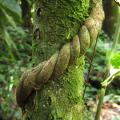
DMT-Nexus member
Posts: 62 Joined: 19-Jan-2013 Last visit: 09-Aug-2025
|
Very interested in any information that anyone might have on this. I've found a few mentions of THH being found in Calliandra angustifolia and C. "pentandra" (which may no longer be a recognized species), but there are no mentions of this anywhere in the published English language scientific literature. My personal contribution: I have worked with Calliandra haematocephala, one of the closest relatives of Calliandra angustifolia within the genus. In the past I have also used a THH/Harmine combination I semi-synthesized from a crude extract of P. harmala. To me, the effects of C. haematocephala are consistent with it containing THH. Many studies around the world have found it testing positive for alkaloids, but none have sought the identity of these alkaloids. C. haematocephala is a beautiful plant commonly grown as an ornamental, and in many places represents a completely unutilized potential source of powerful medicine. I may attempt an alkaloid extraction / bioassay soon. This quote is from Shulgin, TIHKAL #54: Quote:"There are a number of other plants that are known to contain tetrahydroharmine and to have been used in various native preparations. I have recently learned of analysis of an Ayahuasca brew that had used the plant Calliandra pentandra as a component, instead of the usual Psychotria viridis. Ott’s magnificent compendium Pharmacotheon makes mention of a Calliandra augustifolia as a component of ayahuasca, but there is no mention of this pentandra species. The preliminary analysis that I have been given of this decoction is that a component that had initially appeared to be DMT by HPLC analysis had proven to be tetrahydroharmine when assayed by GCMS. There was no detectable DMT present. And yet the material appears to have psychopharmacological activity."
The following is from chemist Jace Calloway, in the 1995 Entheogenic Review: Quote:"However, in a broad (as yet unpublished) survey of Banisteriopsis caapi, Psychotria viridis and subsequent teas, which included phytochemical analyses of all, plus subjective ratings of the teas, a strong correlation was found with teas that contained high amounts of THH and not DMT! This rating was from a large body of experienced users (regular União do Vegetal members who had consumed ayahuasca for 10+ years). In short, yes, there seems to be important activity from THH, but likely not the sort of activity that currently seems valuable to the
lay user in the U.S. or E.U.; e.g., more temporal, than whirly/swirly, if you know what I mean."
...
"Calliandra pentandra has good amounts of THH in the leaves, and it is used as an add mixture by some groups like the Shuar in Equador, and visions have been reported by reliable western folk from this and Banisteriopsis caapi. So, there still may be something there to look at more closely.
...
"I am not aware of any other analyses on this plant species, aside from my own investigations (which are what Sasha refers to in TIHKAL). From my limited perspective, C. pentandra does not contain any DMT, and THH was the major component that showed up in my analysis. These two compounds have quite similar chromatographic characteristics; without mass spectral detection, I would have to doubt any claims that lack such specificity." & here is a phylogeny of the genus Calliandra. https://d1wqtxts1xzle7.c...a5J0xCCZ85jAM01qtIJ3NtRJ~EnWUI7b6w2aKBPv9KlupH0PjGiLlEuXiqSOZyN~GS690ThQPgAFjN-bt~Zyj4Z3Sepu0xmFyA9X~-2SvRduqTTKzEq2YAzVRCZA~6ary5GXmqo68JP-7cP1Iattp54ni-KWgZMW~74j2jKdSDXtrb4GrSaAO5KmOgDFb4GQiu7UaB5wThBenXURaxVX6K5ij8fYEtFb~bQGwDCyOWoAHdr9b6tSGelFbnpams5Ypq-SgMrvweZWE-HnnLdCTe~i3xfZG5qw3UqOhsSEJF1xe8xFQ1oRcML~OTTGQdKCLrlHiGpssGo7Kg__&Key-Pair-Id=APKAJLOHF5GGSLRBV4ZA
|
|
|
|
|

Boundary condition

Posts: 8617 Joined: 30-Aug-2008 Last visit: 24-Dec-2025 Location: square root of minus one
|
Thanks for posting this - it answers a question about C. haematocephala that I posted many moons ago. It seems to confirm the inkling that that plant would have a special value (and that botanical gardeners usually have a good reason for choosing certain plants...) C. haematocephala is really beautiful, its presence is truly lovely. “There is a way of manipulating matter and energy so as to produce what modern scientists call 'a field of force'. The field acts on the observer and puts him in a privileged position vis-à-vis the universe. From this position he has access to the realities which are ordinarily hidden from us by time and space, matter and energy. This is what we call the Great Work." ― Jacques Bergier, quoting Fulcanelli
|
|
|

DMT-Nexus member

Posts: 14191 Joined: 19-Feb-2008 Last visit: 22-Nov-2025 Location: Jungle
|
Let's get it tested.. Keep a sample if you have and pm me in a month 
|
|
|

DMT-Nexus member

Posts: 371 Joined: 01-Apr-2010 Last visit: 04-Apr-2025
|
Thanks - I did not know there were actual actives in Bobinsana. I did a month dieta of tea every day. When consumed this way, the plant intelligence is there and accessible in daily life.
It didn't have a ton to say to me tbh. It did communicate a bit but then trailed off after a few days. Not sure if it is respectful to pick it up again. Or did it hang up the phone?
Wonder if other vegetalista plants are active? Like ayahuma and cats claw?
Thanks again and peace.
|
|
|

Boundary condition

Posts: 8617 Joined: 30-Aug-2008 Last visit: 24-Dec-2025 Location: square root of minus one
|
endlessness wrote:Let's get it tested.. Keep a sample if you have and pm me in a month  I have a dried specimen (leaves, twigs and a small branch) of C. haematocephala somewhere in my extensive piling system. You can either have it as is, or I can get some kind of extract ready. I can keep back some leaves and a twig to accompany the extract. “There is a way of manipulating matter and energy so as to produce what modern scientists call 'a field of force'. The field acts on the observer and puts him in a privileged position vis-à-vis the universe. From this position he has access to the realities which are ordinarily hidden from us by time and space, matter and energy. This is what we call the Great Work." ― Jacques Bergier, quoting Fulcanelli
|
|
|

DMT-Nexus member
Posts: 62 Joined: 19-Jan-2013 Last visit: 09-Aug-2025
|
Does anyone have any suggestions for simple qualitative tests that could suggest the presence of THH in a crude extract?
|
|
|

Boundary condition

Posts: 8617 Joined: 30-Aug-2008 Last visit: 24-Dec-2025 Location: square root of minus one
|
My first approach would be to check the fluorescence of a bobinsana tea - but a 'positive' (blue fluorescence) result would be far from conclusive. You'd at least be guided in the decision whether or not to bother with a general harmala alkaloid extraction, though. “There is a way of manipulating matter and energy so as to produce what modern scientists call 'a field of force'. The field acts on the observer and puts him in a privileged position vis-à-vis the universe. From this position he has access to the realities which are ordinarily hidden from us by time and space, matter and energy. This is what we call the Great Work." ― Jacques Bergier, quoting Fulcanelli
|
|
|

DMT-Nexus member
Posts: 1111 Joined: 18-Feb-2017 Last visit: 12-Jul-2024
|
downwardsfromzero wrote:My first approach would be to check the fluorescence of a bobinsana tea - but a 'positive' (blue fluorescence) result would be far from conclusive. And probably far from likely. I've done many harmaline -> THH reductions and only seen a blue glow once, when the concentration was just right (and fairly low).
|
|
|

DMT-Nexus member

Posts: 14191 Joined: 19-Feb-2008 Last visit: 22-Nov-2025 Location: Jungle
|
TLC would be the best and very easy to see if there's THH.. maybe not extremely simple, but easy enough... You'd get an initial kit with a few tests instead of a single one, but imo it's extremely worth it if you are an amateur chemist that likes doing experiments, testing plants, doing extracts etc.
|
|
|

DMT-Nexus member
Posts: 62 Joined: 19-Jan-2013 Last visit: 09-Aug-2025
|
endlessness wrote:TLC would be the best and very easy to see if there's THH.. maybe not extremely simple, but easy enough... You'd get an initial kit with a few tests instead of a single one, but imo it's extremely worth it if you are an amateur chemist that likes doing experiments, testing plants, doing extracts etc. Do you know a way one could make a tentative identification without having a THH standard?
|
|
|

DMT-Nexus member

Posts: 14191 Joined: 19-Feb-2008 Last visit: 22-Nov-2025 Location: Jungle
|
Stochastic wrote:endlessness wrote:TLC would be the best and very easy to see if there's THH.. maybe not extremely simple, but easy enough... You'd get an initial kit with a few tests instead of a single one, but imo it's extremely worth it if you are an amateur chemist that likes doing experiments, testing plants, doing extracts etc. Do you know a way one could make a tentative identification without having a THH standard? It's extremely easy to identify THH in TLC even without a standard.. Check this out: https://www.dmt-nexus.me...aspx?g=posts&t=35984
|
|
|

Boundary condition

Posts: 8617 Joined: 30-Aug-2008 Last visit: 24-Dec-2025 Location: square root of minus one
|
Jagube wrote:downwardsfromzero wrote:My first approach would be to check the fluorescence of a bobinsana tea - but a 'positive' (blue fluorescence) result would be far from conclusive. And probably far from likely. I've done many harmaline -> THH reductions and only seen a blue glow once, when the concentration was just right (and fairly low). This is actually useful information; if there's a sample tea where the presence of THH is strongly suspected it would make sense to prepare a series of standard dilutions before checking the fluorescence. “There is a way of manipulating matter and energy so as to produce what modern scientists call 'a field of force'. The field acts on the observer and puts him in a privileged position vis-à-vis the universe. From this position he has access to the realities which are ordinarily hidden from us by time and space, matter and energy. This is what we call the Great Work." ― Jacques Bergier, quoting Fulcanelli
|
|
|

DMT-Nexus member
Posts: 1111 Joined: 18-Feb-2017 Last visit: 12-Jul-2024
|
Furthermore, I'd think that if something contains THH, it's also likely to contain harmaline, even if in concentrations of smaller orders of magnitude (as is the case with B. caapi).
Harmaline exhibits strong green fluorescence at a wide range of concentrations, down to trace amounts. To remove the last bit of the glow you have to wash the jar really thoroughly.
With traces of harmaline in the analyte, looking for the faint blue glow of THH may be a bit like looking at a candle in bright sunlight and trying to tell whether it's lit or not.
|
|
|
DMT-Nexus member
Posts: 19 Joined: 15-Mar-2022 Last visit: 12-Jul-2022
|
I have some paste (concentrated water extract) from the branches of bobinsana. I'm going to run some experiments on it. The first test which I've started is to see if raising the pH to 14 causes alkaloids to precipitate out like they do with b. caapi. So far it doesn't look like it. If this doesn't work, I should do a solvent extraction and see what come out. I'm thinking with either chloroform or ethyl acetate as the solvent.
|
|
|

ufa yage chiga ña
Posts: 65 Joined: 10-Oct-2018 Last visit: 12-Jun-2025
|
In the article it mentions of c.petandra , the trees grow in my city in Colombia , after they calls c.magdanelae because grows aside of the river of Magdalena , so is very interesant the mentions javat attached the following image(s):  IMG_20220927_112753880_MP.jpg (6,616kb) downloaded 112 time(s).AYAHUASQUERO DE CORAZON
|
|
|
DMT-Nexus member
Posts: 1 Joined: 29-Oct-2022 Last visit: 01-Nov-2022
|
I've used calliandra surinamensis in various dietas with excellent results, I thought it was the real bobinsana (calliandra angustifolia) because it is often confused with it. My question was, so will all the calliandra species have the same effect?
Has anyone used calliandra surinamensis?
|
|
|

DMT-Nexus member
Posts: 62 Joined: 19-Jan-2013 Last visit: 09-Aug-2025
|
Jagua wrote:I've used calliandra surinamensis in various dietas with excellent results, I thought it was the real bobinsana (calliandra angustifolia) because it is often confused with it. My question was, so will all the calliandra species have the same effect?
Has anyone used calliandra surinamensis? I've used mainly C. surinamensis and C. haematocephala, leaves and flowers. Both "work" well in my experience. I do slightly prefer the surinamensis, although the haematocephala flowers are much larger. C. haematocephala leaves are more astringent so I don't typically use those.
|
|
|

Boundary condition

Posts: 8617 Joined: 30-Aug-2008 Last visit: 24-Dec-2025 Location: square root of minus one
|
Now I wish that I'd collected some of the C. haematocephala flowers when I had the chance. Do you think the leaves might be relieved of their astringency through a tannin removal method? How would you describe the subjective effects of Calliandra? “There is a way of manipulating matter and energy so as to produce what modern scientists call 'a field of force'. The field acts on the observer and puts him in a privileged position vis-à-vis the universe. From this position he has access to the realities which are ordinarily hidden from us by time and space, matter and energy. This is what we call the Great Work." ― Jacques Bergier, quoting Fulcanelli
|
|
|

DMT-Nexus member
Posts: 62 Joined: 19-Jan-2013 Last visit: 09-Aug-2025
|
downwardsfromzero wrote:Now I wish that I'd collected some of the C. haematocephala flowers when I had the chance. Do you think the leaves might be relieved of their astringency through a tannin removal method?
How would you describe the subjective effects of Calliandra? Hmm, could be. Worth a shot. I use the leaves & flowers to facilitate softening, safety, acceptance, and generally an opening into subtle awareness. Subtle yet deep, with no distortions or perturbations of any kind. C. surinamensis and haematocephala are occasionally found in Hawai'i, cultivated for their beauty.
|